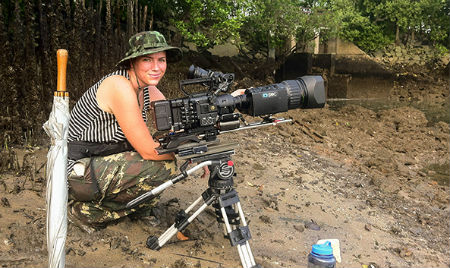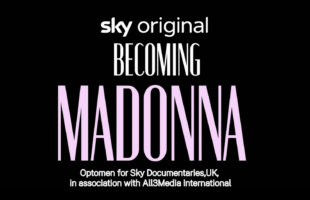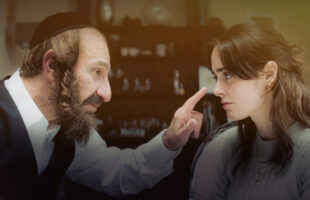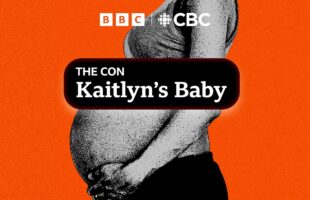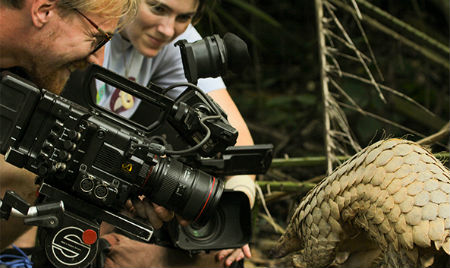
Narrated by natural history legend, Sir David Attenborough, Wild City captures the surprisingly diverse animals and plants which co-exist in a booming city like Singapore. It would be a rare sight for most people living on the island.
The two-part blue-chip documentary was unveiled at a Special Preview for invited guests at the National Library. Minister for Communications and Information and Minister-in-charge of Muslim Affairs, Dr Yaacob Ibrahim, attended the special preview.
Wild City was filmed over a year, and brings viewers through an eye-opening experience inside the Lion City. The two episodes showcase the range of different habitats found in and around the built up urban sprawl, then journey around the island’s hidden wildlife hotspots.
Television Asia Plus speaks to Marc Checkley and Claire Clements from Beach House Pictures in an exclusive interview to find out more about the behind-the-scenes production of ‘Wild City’. Marc also shares upcoming projects from Beach House Pictures, which includes episode 3 of ‘Wild City’, this time covering marine life, and is in development.
Could you tell me more about the technology used in the production of Wild City?
We filmed with quite a few different cameras to get some of the behaviour of the animals. One was the thermal image camera which was brought over from the UK. The tech guy built it from scratch. The cool thing about this camera is that you don’t need any lighting. We were able to film in the dark and that’s really useful for spotting animals that appear in the night. We didn’t have to shine any light on the animals and disturb them and at the same time, we wanted to capture their natural behaviour.
Other cameras we used were 3D cameras that we mounted on trees in an area we know animals would be passing through (or at least we hoped they would). These cameras are triggered by movements. The animals would normally not show themselves if we’re sitting there. That’s also how we managed to capture images of the civet cats. Apparently, they actually How live on roofs of houses.
We also used drone cameras which were essential in capturing shots of the sea eagles.
We used a handheld Sony N5 when we were filming the colugos (sort of like a flying lemur). You can shoot in high frame resolution and yet get it in slow-motion which was essential as the colugos were very fast. We were in the forest and at the corner of the eye, something would move. So without the slow-mo effect, you can’t really see the process of how it jumped. But from the slow-mo shots, we can actually see how the wing membrane of the colugo opens when it jumps. They don’t fly, they actually glide. We started filming before nightfall. It was easier to find them before the last hour of daylight as that’s when they start to wake up and move around. And they take their first jump as the sun goes down. They are quite active for an hour and they start eating and they get active again at 3am and again at 6am. We spent many nights filming this with about an average of two shots per night.
In episode two of Wild City, we used a DSLR to take time-lapses. We set up an environment with plants on the third floor of our production house to mimic the flowers ‘opening’ after the rain. We couldn’t allow anyone to access the area as just one one little disturbance could ruin the entire sequence. A lot of patience went into that.
What were the challenges involved in filming Wild City?
Wildlife filmmaking requires dedication and tenacity. However, it’s heartening to know that there are quite a number Singaporean wildlife enthusiasts. I joined their Whatsapp groups and get messages all day long so it sort of highlights to me everything that is going on out there. I had to be really quick to go over and film it because these animals don’t stay in one spot for a long time.
So did you have to consult anyone before deciding where to go to film?
We worked closely with the National Park authorities. They really supported us on this project. They brought us around to all the different areas where we can find wildlife. We went to places like Sungai Buloh, Bukit Timah and Pulau Ubin. We also worked with NUS for quite a number of researches that helped us out. For instance, there was a lady doing a research on and she was able to help us pinpoint a location where we could possibly find these pangolins. Interestingly enough, there’s a bit of a forest that comes right to the edge of the NTU campus and that’s where the Pangolins are living. They would come out sometimes at night and have an explore of the campus. We went there for five nights in a row and on the fifth night, we finally managed to get in on film. It was amazing. Our whole company knew about it, and it was like, “We got it! We got it!”
Filming Pangolin in Night Safari
Also, the wildlife enthusiasts in Singapore were an incredible part of the planning. There is a Facebook page that I used to post questions on all the time if I wanted to find the whereabouts of an animal or what species it was. They were really quick with their responses; so basically, social networking really helped. I didn’t have to go to the library to look it up and instead had instant feedback.
I’m guessing you guys defeinitely pulled a number of all-nighters. How long did it take to finish filming the show?
We started shooting last April through November. But we had quite a number of productions going on during that time as well. I learnt that the best time to shoot wildlife is in the morning and evening. Apparently, birds are most active at 7am and once it starts getting hotter at around 10am, most animals just go off to sleep.
And we also had an Eagle-filming specialist, who doubles as a tree climber. He had to climb a tree opposite the eagle’s nest and build a sort of ‘house’ from scratch with just some wood and platforms. We do have him in some behind-the-scenes video on the Wild City website as well. It was incredible. He stayed up in the tree covered in leaves for 5 days and only came down to sleep.
What were the costs like for this production?
I doubt I can reveal the overall budget of the show. But just renting the thermal camera alone was so expensive. Probably about $30,000? The camera lens was really expensive. There were so many specialists involved in the production as well. Most of the costs also come from the preparation and research that had to be done before shooting. Moreover, this has never been done in Singapore. There’ve been big blue chip documentaries been done in China, Japan and Korea but still, wildlife documentaries are still pretty niche in Southeast Asia. When this idea was brought up, we knew that it had to be done very well. Otherwise it wouldn’t be special. When our audiences watch it, they can see the way we have captured the animals in their natural habitats. We didn’t want to have to bait the animals as the documentary would then lose its authenticity. What’s also interesting is that we have here is a city which has gone through a lot of changes, but yet there are still pockets of jungles where animals are have made their habitats.
I know quite a number of people don’t know this – but there are otters in the waters at Marina Bay sands. And that is entirely man-made habitat with nice sandy banks that the otters have adapted to. It’s amazing how well they have adapted because some animals will just say, “That’s it. I’m out.” And they would go across the straits to Malaysia but no, they’ve been quite resilient. And it’s important for them to know no one’s fishing or hunting them. I think that’s what the heart of Wild City is about.
Do you think Singapore has done enough in making places habitable for these animals?
Singapore has been doing so much so far to make spaces for the animals. It’s an amazing city in terms of having so much greenery as compared to places like Taipei or Hong Kong.

Filming Hornbills in apartment
What do you hope that viewers will take back with them from watching Wild City?
We are hoping that the show will spark interest among Singaporeans to want to find out more about wildlife. Young Singaporeans are very urbanised and their interaction with animals is very controlled – you either have to visit the zoo or the park. For them to realise that there are such animals coexisting among them, it will hopefully garner some interest and bring more support into preserving the wildlife.
Were there many crew members involved in the production?
When filming the colugos, we needed help with lighting, so I took about five lighting crew members along to basically handle the light stands as it wasn’t very stable. Usually with wildlife you don’t want too many people because it will scared the animals. If I was filming, I’d have a group of just about two of us. That was it.
Filming Mudskippers in Sungei Buloh
What’s next for Wild City?
For Channel News Asia (CNA), they have big plans for Wild City. The concept of Wild City is very universal, and that’s what we’re really excited about. The idea of this third episode is already in talks. It’s not been greenlit yet, but CNA is definitely looking to develop something new. Most likely, we’ll be covering marine this time round. It’s a big investment but it’s understandable that SG50 will be a perfect platform for the launch. There are so many aspects to consider when covering marine life, such as technical equipment used and having to film underwater, as well as having divers who have skills essential to filming. Diving is one thing but filming is different. I’ve done some filming underwater. Because of buoyancy, everything is magnified. And just what sea creatures we’ll be capturing will take a lot of patience. Gone are the days where you shoot from a distance and just simply zoom in. We ourselves, as audiences, expect things to be more front and centre. That’s where some equipments help us. It used to be up to the people in Animal Planet and BBC but you can see that this is being done by a production house in Singapore. It will definitely be much more challenging. There’s an area down by Sisters Island declared as a reserve for the reef which we can use as one of the filming spots. I think we have set a very good bar on what we can produce in this area, and the talent we have in this region to do it.
CNA is a regional broadcaster and also has gone through a revamp on how and what sort of content is put out for audiences. We’re working on something big at the moment which will be launched at the end of the year.
CNA will be working to distribute Wild City across other urban centres in the world as a format. You don’t normally see natural history being presented this way but I think it’s an amazing opportunity because Singapore is not the only one with these habitants dealing with survival amongst the rest of us in a concrete jungle. We are looking at countries such as Bangkok, China, and even North America. There was an idea for Vancouver where we have Wild City Vancouver. These have potential in moving to OTT and VOD where you could actually start a world series. It will take some time to work things through, but CNA has been very supportive throughout.
Wild City sorts of markets itself. CNA is looking to internationalise the show. Having such a renowned naturalist such as Sir David Attenborough narrating the show is marketing that you cannot pay for. People know what he has gone through and how invested he is in wildlife. That again, is what makes this programme so international and so recognisable. There’s where the opportunity to roll out Wild City across multiple territories and captures wildlife in multiple cities. It’s an amazing opportunity.
On top of that, there were quite a number of ministers who actually tweeted about Wild City, so this in a way is proof that the show is successful and has garnered so much attention. Hopefully, along with this, there will be changes in how wildlife is being preserved in Singapore. That would be a great outcome.
Why Sir David Attenborough?
He is considered to be the man, THE wildlife narrator and brings with him much authority and a massive amount of credibility. When we approached him, he had to approve the entire programme and script first before agreeing to come on board as the narrator. We showed the script to him and he was happy with it. On the day of the recording for the voice-overs, he had a couple of changes with words he wanted to discuss. He definitely knows what he wants.
He actually inspires people to work in the wildlife field. I actually received an email from a Singaporean running the new reserve here. She grew up watching David Attenborough and it sort of become an inspiration. She said that watching him narrate to Singapore’s wildlife is very emotional.
He has adapted to the way documentary film-making has change through technology – the way we capture things. He used to be front and centre in his programme but that’s not always necessary now because of the way we’re capturing it. His voice obviously brings so much strength to it. But technology has changed our expectations of the programme as well as the way we capture it. Wild City is most up to date in the way wildlife is captured.
Any upcoming projects for Beach House Pictures?
We’re working on Photo Face-Off for Discovery Channel. We worked on Asia’s Next Top Model Cycle 3 which was launched on March 25. We’re also working on doing Luxe Asia and a couple of series for MediaCorp, as well as a kids programme called Hiccup and Sneeze which will be out in August. We’ve also had China From Above, so there’s so many things in store for Beach House Pictures and we’re looking forward for more to come.



